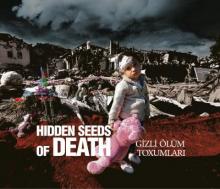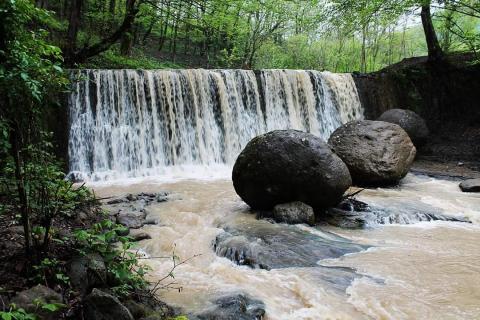
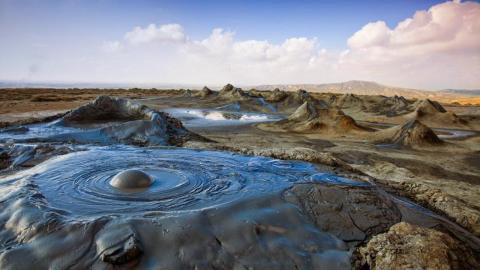
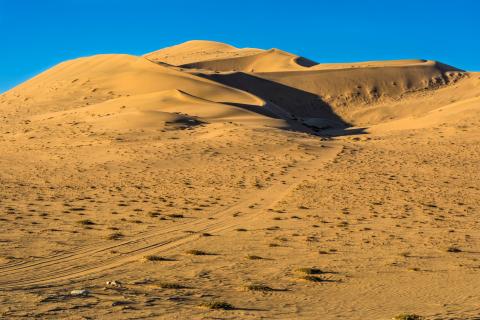
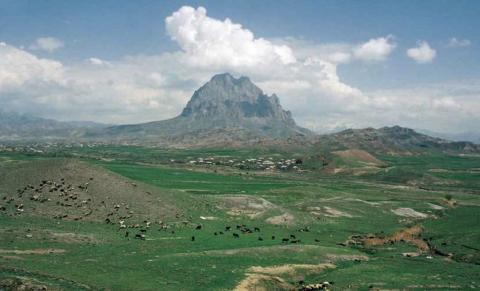
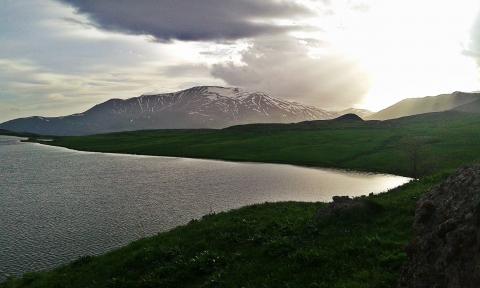
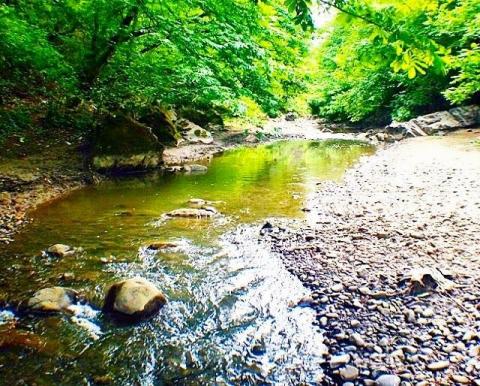
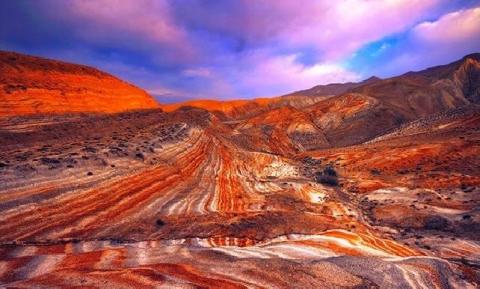
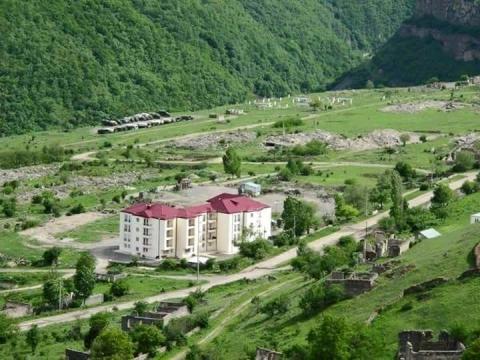
Budag Budagov, True Member of Azerbaijan National Academy of Sciences
The territory of the Azerbaijan Republic, as well as the entire Caucasus is situated on the subtropical zone which has particular effect on the formation of specific climatic types and subtypes.
İt is not surprising, that out of 11 world climatic types, 9 occur in a relatively small territory of Azerbaijan (88, 6 km2). The country is characterized by a diverse landscape: for instance in a small distance (40-60 km), it varies from 28 km below sea level to 4480 km (m.Bazardyuzi) elevation.
The territory of Azerbaijan is rich with minerals such as iron, magnesium, titanium, chromium, copper, polymetals, cobalt, molybdenum, Icelandic shtap, andalusite, rock crystal, quartz, barite, alunite, andalusite, asphalt, rock salt. There are 10 different types of mineral springs in Azerbaijan which include: hydrocarbonate, hydrocarbonate-chloride, hydrocarbonate-chloride-sulfate, hydrocarbonate-sulfate, chloride, sulfate-chloride, and etc. Natural monuments of Azerbaijan can be distinguished as geological, geologo-morphological, geomorphological, hydrological, floristic, faunistic and that which refers to landscape.
Geological monuments of nature. The territory of Azerbaijan, as the entire territory of the Caucasus, belongs to a belt of Alpine folding and has a complicated tectonic formation.
Climatic conditions, regression of the sea as well as the geological and geomorphological processes going on for the last 13-15 thousand years have developed a unique form of relief in the territory of the Azerbaijan Republic. The aged rocks of the Lower Pliocene period including Modern deposits fascinate the viewer. The oldest rocks are the deposits of the Lower Paleozoic period, composed of metamorphosed schist. The territory of Azerbaijan is also rich with paleontological and mineralogical deposits. Effusive-magmatic and deposit rocks as well as a range of factors associated with time and space that reflect the paleontological conditions and natural resources allow determining the age of these rocks. Shell composites of huge boulders help to date them back to the age of Cretaceous and post- Cretaceous period.
Unique stones of various geological periods and particularity of the territory as a whole represent an interesting element that attracts tourists. Mountain rocks range from 570 million years (schist, gneisses) to the age of modern marine sediments (limestone, silt, sand, gravel, and etc). Another prominent geological monument is a Sarmatian sediment preserved on the absolute height of 3600 m, sometimes observed in single relict forms. Similar deposits are also observed in other areas of the Caucasus. It is suggested to declare areas rich with these deposits such as Shakhdagh, a protected zone.
Geological and geomorphological monuments of Azerbaijan are rather diverse. Mountains, hills and different rocks emerged by arid-erosive reliefformations. Some of them are composed of intrusive (Ilanlydag, Nahadjar, Alinja and other mountains in the Nakhchivan Autonomous Republic) and the ancient crystalline rocks of the Devonian period (Dakhna, Sarydag, Velidag and other relict mountains of Nakhchivan), while other formations are rich with Pliocene sediments (relicts of Ambizler, Gushgayasi in Gobustan). In connection with the process of intensive denudation and erosion easy-eroded rocks gradually disappeared. There is also Dibrar type of cliffs in the south-eastern Caucasus. These cliffs are made of Lusitanian limestone of the Cretaceous period. They are usually expressed in the form of sharp-edged rocks. Curious tourists and mountain climbers spend hours viewing the remnants of the towers erected on these rocks centuries ago for defensive purposes (Chyraggala, Sekhyubgala, etc.); some of them are preserved in Shabran (Chyraggala) and Ismailli (Talystan) rayons. Mount Kapaz formed by limestone of the Jurassic period fascinates tourists with its unique beauty.
Before the end of the nineteenth century oil resources were extracted by 10-15 deep hand-dug wells in the Absheron peninsula. Produced raw oil was collected in pits dug around the wells. Such wells are still preserved around the districts of Khirdalan, Balakhani, Bineqedi, Fatmayi and Hokmeli. They illustrate the wealth of oil fields in Azerbaijan, the proximity of oil plast to the ground surface, and the hard work of oil producers in the past days. To preserve these monuments for future generations, we need to restore old oil wells and to declare their territory a protected zone, due to their significance for the history of Azerbaijan. Spontaneous combustion of natural gas flowing through tectonic fractures to the ground surface and the flame coming out of it displays a unique phenomenon against the background of green vegetation or white snow. In the ancient past flame of natural gas was a place of worship of pagan religions. Pilgrims from India built a Zoroastrian temple here. Yields of methane gas are also observed in the craters of active mud volcanoes, which are not few in Azerbaijan. One can also observe natural gas emissions on the southern slopes of the Gizilgaya plateau, to the west of the Hinalyg village at absolute altitude of 2200 m from the shale to the surface of ground. Its flame creates a unique pattern against a background of steep cliffs and mountain meadows. It is an attractive place where curious tourists can cook barbecue on hot sandstones.
Among hydrogeological monuments mineral springs are noteworthy. They are widely distributed on the territory of Azerbaijan: springs with more than 10 different chemical compositions have been discovered in the country. These include hydrocarbonates, hydrocarbonatechlorides, hydrocarbonate-chloridesulfates, hydrocarbonate-sulfates, chloride-hydrocarbonates, sulfatechlorides and vitriolic. In addition to these there are a number of sources with unknown chemical compositions. Debit of these resources range from 10 to 100 thousand liters per day. More than 30 springs are distinguished with temperature ranging from 20 to 70 degrees. Most of the mineral springs have sulphur, carbon, and carbon disulfide gas emissions. They are generally used to treat patients with gastro-intestinal, skin, cardiovascular, and rheumatic diseases. Mineral sources of therapeutic significance include Darydag, Sirab, Badamli, Turshsu, Shirlan-Istisu, Slavyanka, Agkerpu, Khaltan, Khashy, Jimy, Khalkhal, Beshbarmag, Gyrhbulag and others. We believe that it is reasonable to declare sources of these springs zones of reserve.
Hydrologic monuments. Natural streams of Azerbaijan are mainly Mountain Rivers. Elevations between the upper and lower reaches of the river flows sometimes vary between 2000-3000 m while the distance from the mouth of the river to its entrance into the plain area changes between - 15-20 to 30 km. Therefore, rivers flowing through deep gorges and the noise of their fluxes produce strong echo to the distant environment and charm the listener. This beauty is attributable to Qusarçay, Kishchay, Terterchay, Nakhchivanchay, Lankaran and other rivers of Azerbaijan. Waterfalls appear during certain climatic conditions. There are 2 types of waterfalls within the boundaries of the country: waterfalls inherent to permanent and temporary mountain rivers such as Afurdja (Velvelchay), Mychig (Damiraparanchay), Hamzali (Hamzalichay), Katek (Katekchay), Kirintov and Sariguney (Kishchay), Ilisu (Kurmukhchay), etc.
Mountain lakes of Azerbaijan, reflect a boundless sky. Highland Lakes such as Tufan (Greater Caucasus), Goygol, Alagellar (Lesser Caucasus), Batabat (Nakh. AR) and others are known for their unique attraction.
Floristic monuments. Flora is one of the distinct components of the landscape. Change of landscape at plains and mountains is a result of different natural factors impacting relief. Therefore, flora is not only one of the major components of physical and geographical environment, but also a criterion of the internal structure of the landscape, the formation of which is due to mutual landscape forming factors. Floristic monuments enrich the natural environment. For example, 1500-1700 old plane trees observed along the roads are an invaluable natural gift. Since past, these trees were carefully preserved. The famous eastern plane trees are preserved in many places of Azerbaijan - Nagorno-Karabakh, Geranboy and other areas.
Other floristic monuments are Sultanbud forests (pistachio), Goygol pine and others. These zones are protected as natural reserves. Valuable floristic monuments include: narband (Nakh. AR), elm tree (Apsheron Peninsula), chestnut tree (Gabala), zubovnik (Zagatala, Khachmaz districts), and etc. Pyramidal plane trees along Guba-Khachmaz highway, nut plantations along the Oghuz-Sheki Zagatala-Balaken roads create a picturesque landscape. Endemic and relict flora (argan tree, chestnut oak, zelkova, etc.) of Azerbaijan must be preserved as a valuable national treasure.
Faunistic monuments - Dagestan auroch, bezoar goat, mountain sheep, deer, wild boar, brown bear, gazelle attract the attention of tourists and alpinists. Animals like porcupines, grouse, francolins, doves, swallows enliven the nature of the Eastern Caucasus. Far-sighted eagles highlight the majestic beauty of nature. Animals imported to Azerbaijan, including the Ussuri sika deer have adapted to the local conditions and can also be attributed to living natural monuments of the country.
Sometimes, we witness rare Asian, European and African birds in some natural reserves and wildlife preserves: flamingos, swans, bittern, pelicans, sultan and others. Knowledge of this birds has a cognitive and aesthetic significance. Tourists are showing special interest towards paleozoological monuments of nature. A better demonstration of this natural phenomenon is the Binagadi bitumen disposal of animals, formed 70-80 thousand years ago in the Upper Pliocene period. It is known that some species of fauna of the Absheron peninsula disappeared in the bitumen lake in the Quaternary period. This lake formed as a result of a natural outcrop of oil which embalmed bodies of dead animals. Scientists discovered the remains of a bull, giant deer, numerous representatives of vertebrates, reptiles, mammals, insects and birds here. Similar paleontological fields are also found in other places of Azerbaijan (Jeyranchol etc.).
Unique landscapes. The variety of climatic conditions in Azerbaijan led to the formation of unique landscape complexes. An example is Khaltan depression (1000-1800 m), situated in the north-eastern part of Azerbaijan in the upper reaches of Gilgilchaya and Velvelichay rivers. To the north it is bordered by the ridge of Gaytar-Goja while to the south – by the main Caucasian ridge. In the entrance of Gilgilchay, the ridge of Gaytar-Goja forests are replaced by high meadows and the latter by the rocky watershed.
Goygol is an indivisible part of the natural landscape of the country. Similar unique phenomena are also found in other parts of Azerbaijan. According to their place of significance we can divide Natural Monuments into three groups:
The first group includes natural monuments of international importance (Ilanlidagh in the Nakhchivan Autonomous Republic, Goygol and Gizilaghchay ornithological reserves, Girkan forests of Talish Mountains, Binagadi paleontological monument). The second group consists of natural monuments evaluated in the country level (plane-alley, unique mineral springs, mountain Beshbarmag, beautiful waterfalls, etc.). The third group covers natural monuments of local importance: oak groves, some thermal and mineral springs, ancient trees, and etc. It is very important to preserve monuments of nature as an invaluable heritage handed over to the mankind since ancient times. Responsibility for their safety should be passed from generation to generation. To do this, we must prepare a list of these monuments and carry out safety measures at the state level, involving the ordinary citizens.




